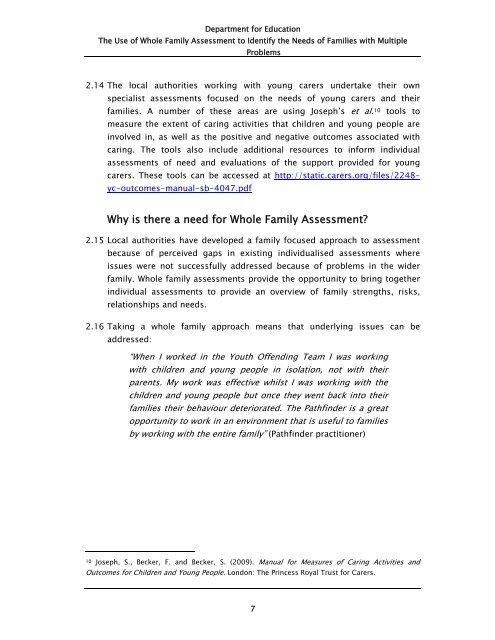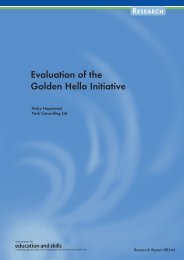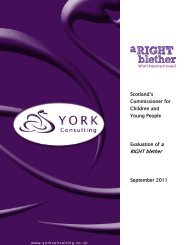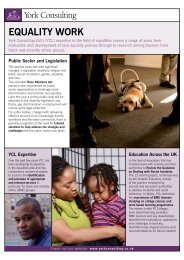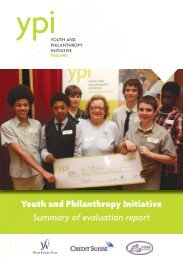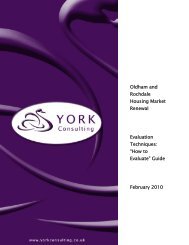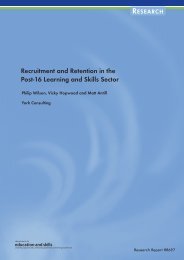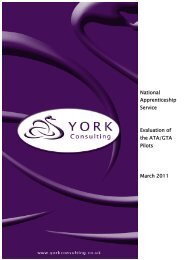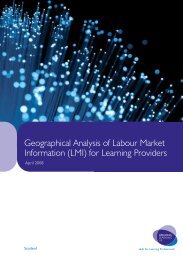The use of whole family assessment to identify the needs of families ...
The use of whole family assessment to identify the needs of families ...
The use of whole family assessment to identify the needs of families ...
You also want an ePaper? Increase the reach of your titles
YUMPU automatically turns print PDFs into web optimized ePapers that Google loves.
Department for Education<strong>The</strong> Use <strong>of</strong> Whole Family Assessment <strong>to</strong> Identify <strong>the</strong> Needs <strong>of</strong> Families with MultipleProblems2.14 <strong>The</strong> local authorities working with young carers undertake <strong>the</strong>ir ownspecialist <strong>assessment</strong>s foc<strong>use</strong>d on <strong>the</strong> <strong>needs</strong> <strong>of</strong> young carers and <strong>the</strong>ir<strong>families</strong>. A number <strong>of</strong> <strong>the</strong>se areas are using Joseph’s et al. 10 <strong>to</strong>ols <strong>to</strong>measure <strong>the</strong> extent <strong>of</strong> caring activities that children and young people areinvolved in, as well as <strong>the</strong> positive and negative outcomes associated withcaring. <strong>The</strong> <strong>to</strong>ols also include additional resources <strong>to</strong> inform individual<strong>assessment</strong>s <strong>of</strong> need and evaluations <strong>of</strong> <strong>the</strong> support provided for youngcarers. <strong>The</strong>se <strong>to</strong>ols can be accessed at http://static.carers.org/files/2248-yc-outcomes-manual-sb-4047.pdfWhy is <strong>the</strong>re a need for Whole Family Assessment?2.15 Local authorities have developed a <strong>family</strong> foc<strong>use</strong>d approach <strong>to</strong> <strong>assessment</strong>beca<strong>use</strong> <strong>of</strong> perceived gaps in existing individualised <strong>assessment</strong>s whereissues were not successfully addressed beca<strong>use</strong> <strong>of</strong> problems in <strong>the</strong> wider<strong>family</strong>. Whole <strong>family</strong> <strong>assessment</strong>s provide <strong>the</strong> opportunity <strong>to</strong> bring <strong>to</strong>ge<strong>the</strong>rindividual <strong>assessment</strong>s <strong>to</strong> provide an overview <strong>of</strong> <strong>family</strong> strengths, risks,relationships and <strong>needs</strong>.2.16 Taking a <strong>whole</strong> <strong>family</strong> approach means that underlying issues can beaddressed:“When I worked in <strong>the</strong> Youth Offending Team I was workingwith children and young people in isolation, not with <strong>the</strong>irparents. My work was effective whilst I was working with <strong>the</strong>children and young people but once <strong>the</strong>y went back in<strong>to</strong> <strong>the</strong>ir<strong>families</strong> <strong>the</strong>ir behaviour deteriorated. <strong>The</strong> Pathfinder is a grea<strong>to</strong>pportunity <strong>to</strong> work in an environment that is <strong>use</strong>ful <strong>to</strong> <strong>families</strong>by working with <strong>the</strong> entire <strong>family</strong>” (Pathfinder practitioner)10 Joseph, S., Becker, F. and Becker, S. (2009). Manual for Measures <strong>of</strong> Caring Activities andOutcomes for Children and Young People. London: <strong>The</strong> Princess Royal Trust for Carers.7


